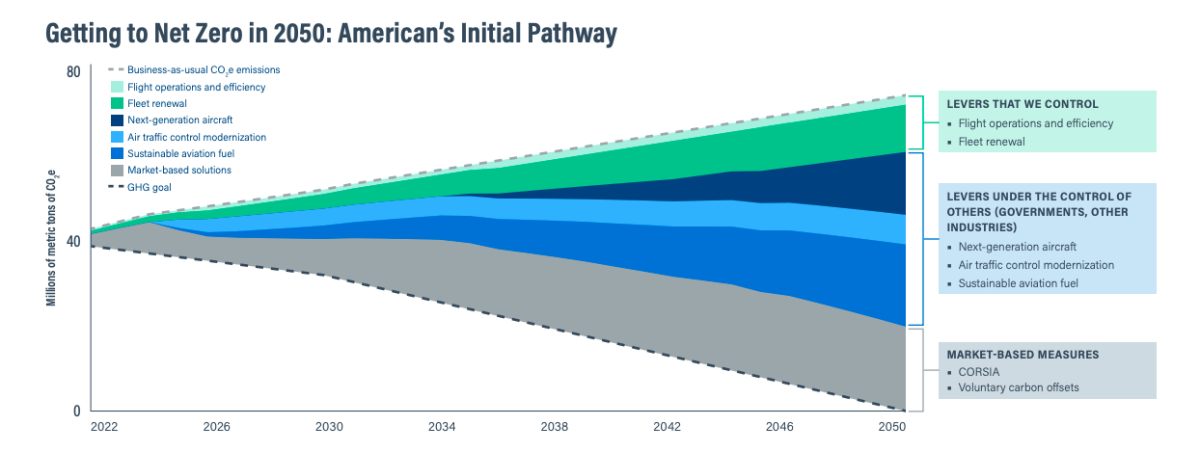Getting to Net Zero in 2050: The Initial Pathway for American Airlines

American Airlines Environmental, Social, and Governance Report 2019 - 2020
American’s strategy to achieve net zero carbon emissions by 2050 is focused on driving operational and technical improvements that reduce GHG emissions by continuously improving fuel efficiency and substituting petroleum-based fuels with lower-carbon alternatives. American also expects to rely on market-based mechanisms, including carbon offsets, certainly over the short to medium terms and potentially over the long term as well, depending on how quickly the market for sustainable aviation fuel develops. In parallel, American is helping to facilitate the broader policy, market, infrastructure and technological advances needed to enable the transition to low-carbon aviation.
American is targeting its efforts on where the airline can have the most meaningful near-term impact in reducing its carbon footprint and mitigating its most significant climate-related risks. The following outlines the key components of American's climate strategy.
Aircraft Fuel Efficiency
Jet fuel consumption is the chief source of American's direct GHG emissions and one of the largest categories of expense for the company. As a result, maximizing the fuel efficiency is both a core focus of the airline's climate change strategy and a key business objective.
Over the past several years, American has undertaken the most extensive fleet renewal effort in the history of their industry. Since 2013, American has taken delivery of 550 new, more fuel-efficient aircraft — an investment of $23 billion — including the Boeing 787 and the Airbus 321neo, which were developed with the latest engine and airframe technologies.
Over the same period, American retired a similar number of older, less fuel efficient planes, including retiring the last of their McDonnell Douglas MD-80 aircraft in 2019. And because of the reduction in demand due to the COVID-19 pandemic, American accelerated the retirement of four additional aircraft types — Embraer E190s, Boeing 757s, Boeing 767s and Airbus A330-300s — and certain older regional aircraft. In addition, the airline anticipates increased fuel efficiency as the Boeing 737 MAX comes back into service. The MAX is 35% more efficient than the fleet of Boeing 757s retired earlier this year.
American's fleet renewal effort will have the greatest near-term impact on emissions, since each new generation of aircraft targets fuel-efficiency improvements of 10–15%, though there are factors beyond the aircraft itself that affect fuel efficiency. Over the long term, American expects to rely on future technologies, including new engine and aircraft technology, air traffic control reform and sustainable aviation fuels, to achieve net zero emissions by 2050.
Operational Efficiency in the Air and on the Ground
Alongside fleet renewal efforts, American is investing in new technology to help their aircraft operate more efficiently. For example, in 2020 the airline began deploying specialized software that uses real-time weather conditions to provide their flight crews with better data about optimal flight altitudes and speeds. This can save fuel and reduce emissions, particularly on long-haul flights. By mid-2020, American was using this technology on 85% of their mainline aircraft.
American is also reducing jet fuel consumption pre- and post-flight. This on-the-ground fuel use represents approximately 6% of its total jet fuel consumption. For example, the airline is are reducing the use of onboard auxiliary power units (APUs) during flight preparation by connecting to ground power at the airport terminal, rather than relying on jet fuel to heat or cool the aircraft, operate onboard lighting and run other functions while the aircraft is parked at the gate. This simple change in operational behavior provides a substantial opportunity to decrease both costs and emissions, since electric power is less carbon intensive. By reducing the time an APU is run by just one minute on every flight, it's estimated that an aircraft can save 1,000 gallons or more of jet fuel annually. Other changes include increasing the use of single-engine taxi operation (i.e., using just one aircraft engine to taxi to the gate after landing). This technique reduces the carbon emissions produced by taxiing by 20–40%.
American is also working to reduce excess weight on each aircraft, from using lighter materials on board to optimizing the amount of extra fuel each flight carries.
The next largest source of American’s direct GHG emissions after jet fuel — albeit a distant second, representing only 1% of its Scope 1 emissions — comes from the fuel used by required ground service equipment (GSE), such as baggage carts, cargo loaders, pushout tractors and maintenance equipment. As part of the airline's climate strategy, we are purchasing low-emission GSE vehicles and working to transition from diesel- or gasoline-powered GSE to electric GSE. In 2019, American added more than 50 electric-powered vehicles to its GSE fleet.

